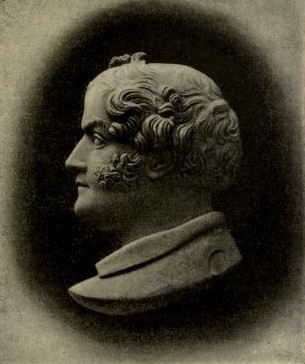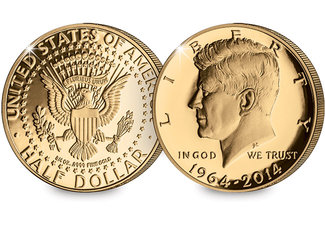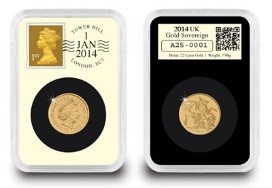Posts Tagged ‘Gold’
The coin that caused a modern day gold rush
People tripped, fell and were trampled on in the rush to get in line at the U.S. Mint in Denver on 7th August. They were all after one coin – the John F. Kennedy 50th Anniversary Gold Half Dollar.
After the official launch at the ANA World Money Fair in Chicago, thousands of collectors queued up at U.S. Mint locations each day in the hope of securing one of the 500 coins due to be released daily, with most selling out in just a few hours.
The rush was so intense that the police had to be called to calm things down. The US Mint were eventually forced to suspend in-person sales of the coin and released the following statement:
“The United States Mint and the American Numismatic Association (ANA) announced today that sales of the 2014 50th Anniversary Kennedy Half-Dollar Gold Proof Coin have been suspended at the ANA’s World’s Fair of Money in Rosemont, Ill. The Mint and the ANA made the decision to ensure the safety of those wanting to purchase the coin and the safety of their own employees.”
Why did this coin cause such a frenzy?
Issued to mark the 50th anniversary of the first Kennedy half dollar, it is the first ever US half dollar to be issued in 24 Carat gold. The reverse design also features a ring of 50 stars – more than any other US coin produced for circulation.
In fact, dealers were so keen to get hold of the first release coins they were buying the coin straight back off members of the public and some were even offering people $600 to queue and buy the coin for them.

The Westminster Collection managed to beat the rush and reserve a limited number of 2014 Anniversary JFK Gold Proof Half Dollars.
NOW SOLD OUT
£516,000 Gold Sovereign breaks auction record for a Royal Mint coin
It’s every collector’s dream to find a significant coin which is worth a fortune. And they don’t come any more significant than the Edward VIII Sovereign which has just smashed an auction record and netted £516,000.
The incredibly rare 1937 dated gold ‘proof’ coin is the only single example available to collectors anywhere in the world. It was struck ahead of the King’s Coronation, however following the scandal which predicated Edward’s abdication from the throne in 1936, the coins became redundant and cemented their place in collecting folklore.
His left-facing portrait; the same as his predecessor George V, also represents a unique deviation from a tradition which started in the 17th century under Charles II who wished to be facing the opposite way to Oliver Cromwell.
“In the world of coins, it’s the coin’s story that makes it important and this coin has the most fantastic story” said winning bidder Mr Jordan Lott of Regal Rare Coins in Chester.
After a tense battle in the Baldwin’s auction room and some fierce bidding, the coin eventually reached a winning bid of £430,000 and with fees included this took the total price to £516,000.
It was money which Mr Lott was happy to pay; “I was the first to bid and I was determined to be the last. I would have paid another £50,000 to make sure I got it.”
The price is the highest ever recorded for a sovereign coin struck by the Royal Mint in the UK and possibly the best example of the numismatic significance of British coins in the collecting world.
The Making of a British Icon
How an Italian engraver produced the most British coin of all time
Across the world, one coin is seen to epitomise all that it is British in a way that compares with nothing else. That coin is the Gold Sovereign. And at the centre of its international reputation is a quintessentially British design – St. George slaying the dragon.
Yet it is not, as you may first think, the work of a classical British artist, but instead that of the second son of an Italian federal court judge, who only came to England just two years before his portrayal of St. George and the Dragon first adorned a British coin in 1817.

Cameo of Benedetto Pistrucci, by his daughter c. 1850
In fact well before his arrival in England in 1815, Pistrucci was already well established as a leading gem engraver and producer of fine cameos amongst European high society. He rapidly made an impression on his arrival in London, winning the approval of the well-known antiquarian William Richard Hamilton.
Despite having no coin or medal experience, he was quickly commissioned by the Master of the Mint Wellesley Pole, brother of the Duke of Wellington, to produce a new portrait of George III as part of the Great Recoinage. His model, created in the unusual medium of red jasper, was re-engraved by Thomas Wyon for its final use on coinage losing, in Pistrucci’s eyes at least, much of the detail.
However, his work was clearly of sufficient quality to impress Pole, who followed up with a commission for the design that has forever since been the synonymous with the name Benedetto Pistrucci – St. George and the Dragon.
A design nearly lost the annals of history
Yet within just eight years it looked like Pistrucci’s design might disappear forever, as the Royal Mint changed the Sovereign reverse design to an heraldic shield, which was to remain in place for the next 46 years.
It was only a drive to improve the design quality of the coinage, led by new Deputy Master, Charles Fremantle that saw the re-introduction of St. George in 1871. However, both reverse designs were struck concurrently until 1887 when the Chancellor of the Exchequer declared that “by tradition and recommended by the great beauty of the design” Pistrucci’s design should once again appear on all Gold Sovereigns.
“The chief coin of the world”
By the mid-1850s the “new” Gold Sovereign had become a coin of true international status. Indeed an official list identifies no fewer than thirty-six colonies and dependencies in which the gold sovereign or half sovereign was recognised as legal tender.
More surprisingly, so great had become the reputation of the British sovereign that it was also in regular use in other countries outside the Empire, including Brazil, Egypt and Portugal.
However, it was the opening of the Sydney branch of the Royal Mint in 1855 following the discovery of gold in Australia that really marked the international growth of the Sovereign. Initially authorised to strike Sovereign’s to a different design, in 1871 Sydney finally started to strike coins of the same designs as the UK (just in time for the Pistrucci revival), only identified by a small “S” mintmark.
Further Australian Royal Mint branches followed in Melbourne in 1871 and Perth in 1899, before the Mint’s reach extended to other Empire countries with branches opening in Ottowa (1899), Bombay (1918) and Pretoria (1923) – all producing Gold Sovereigns.
It is no wonder that the eminent economist of the early 20th Century, Sir John Clapham, proclaimed the Gold sovereign as “the chief coin of the world”.
A worldwide modern icon – good enough for 007
The last international sovereign was struck in Pretoria in 1932. By then the international interest in Gold Sovereign, which started in Victorian times was well and truly established. And it is a reputation that continues right up to today.
Ian Fleming chose to equip James Bond with 50 Gold Sovereigns in his attaché case in the From Russia with Love, whilst Special Forces are still believed to carry Gold Sovereigns, as an emergency international currency.
In 2012 the Royal Mint once again authorised the striking of the St. George and the Dragon Gold Sovereign outside the UK under licence in India, so great is its popularity amongst the people there.
Reference
“The Royal Sovereign 1489 – 1989”, Ed GP Dyer
“A New History of the Royal Mint”, Christopher Edgar Challis
The Royal Mint Museum Website
________________________________________________________________
The 2014 Gold Sovereign is available in a limited edition DateStamp™ Presentation of just 995 pieces –now sold out.




